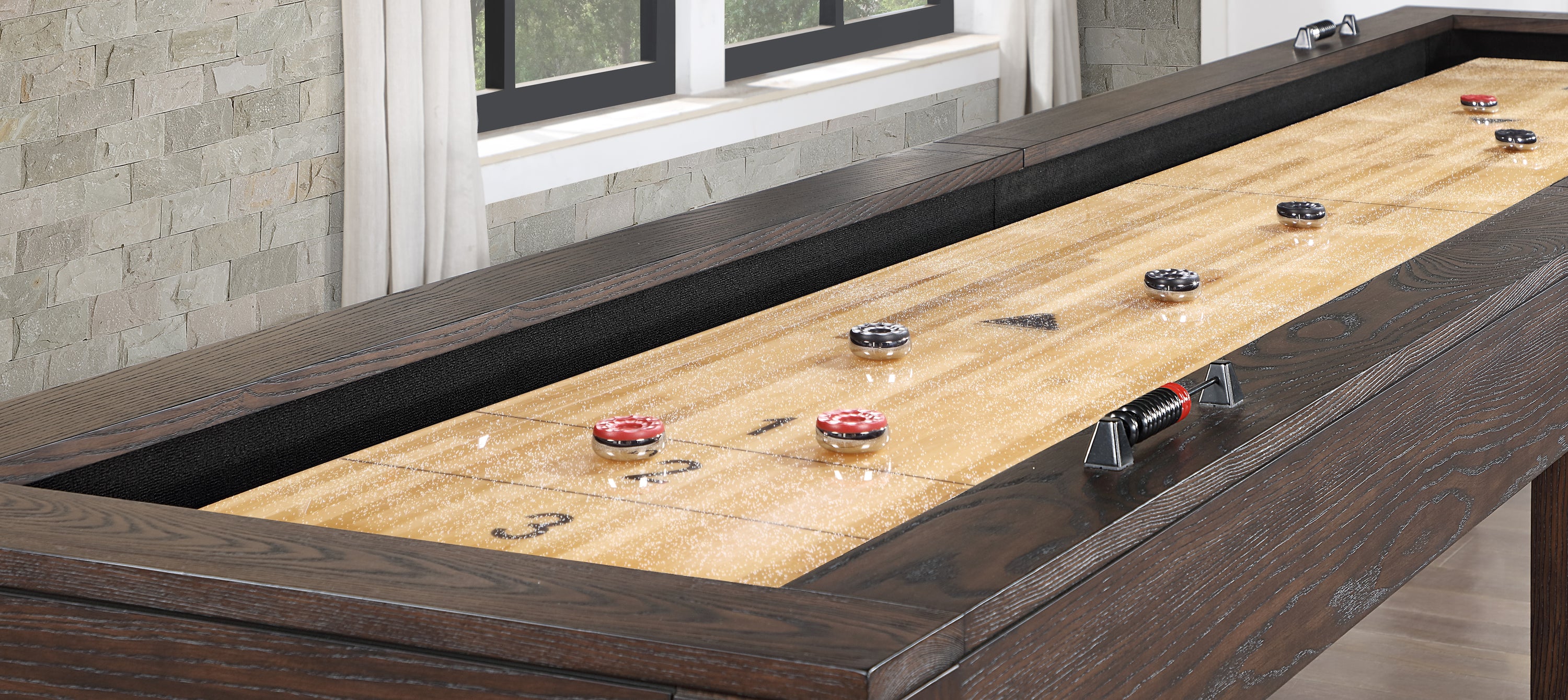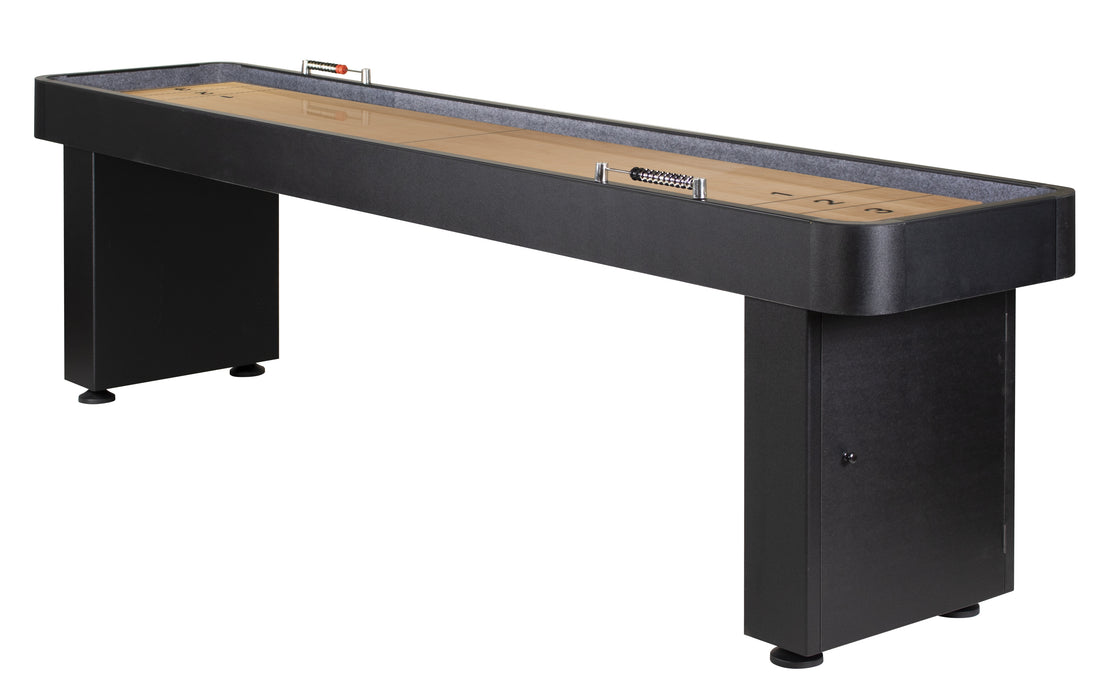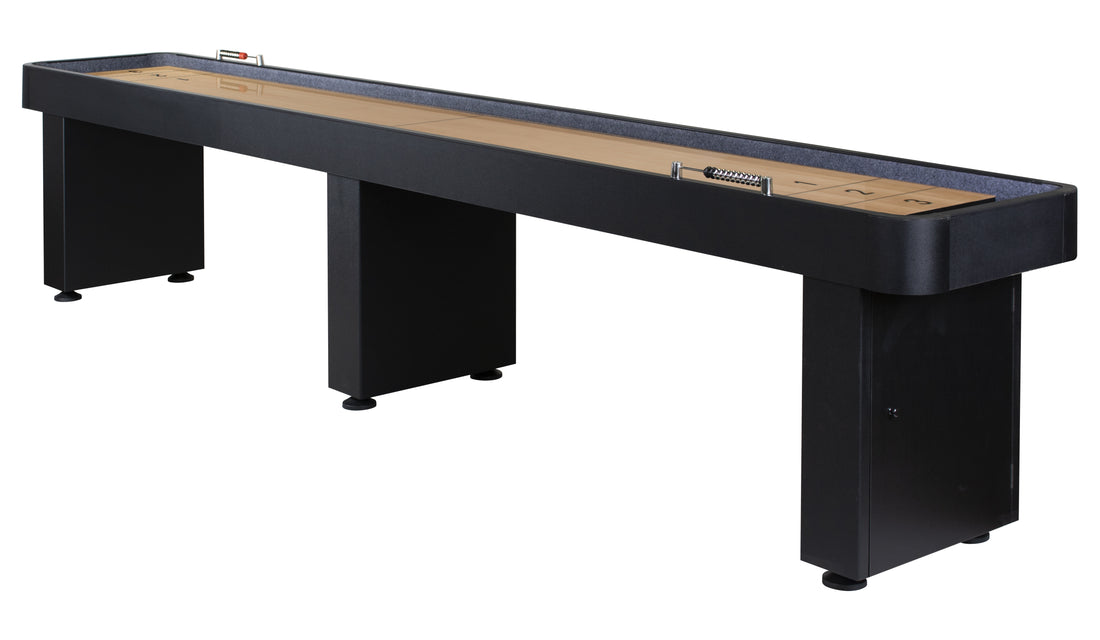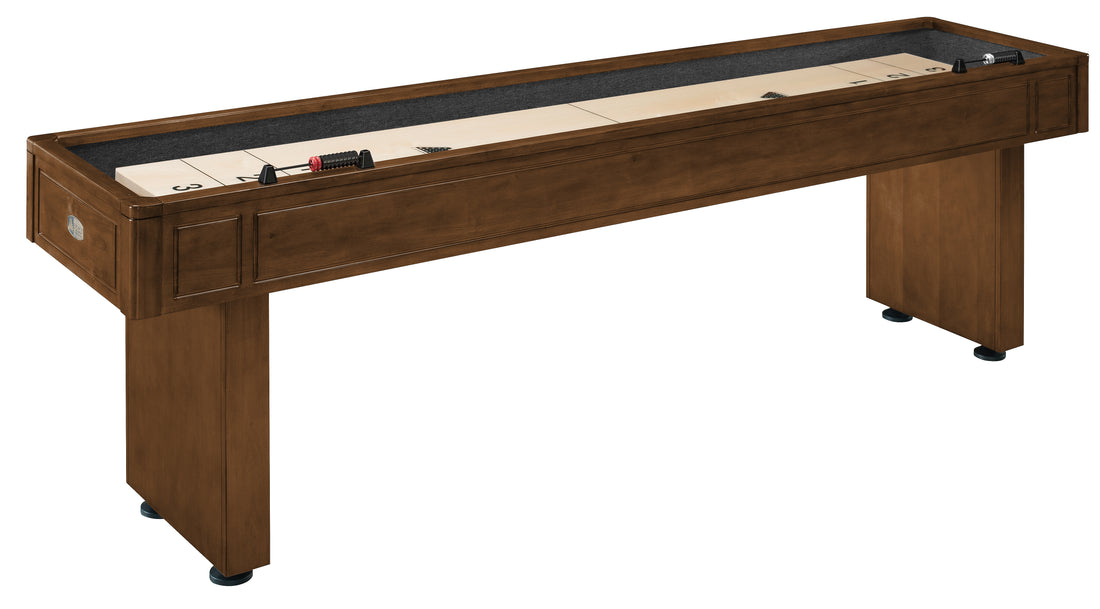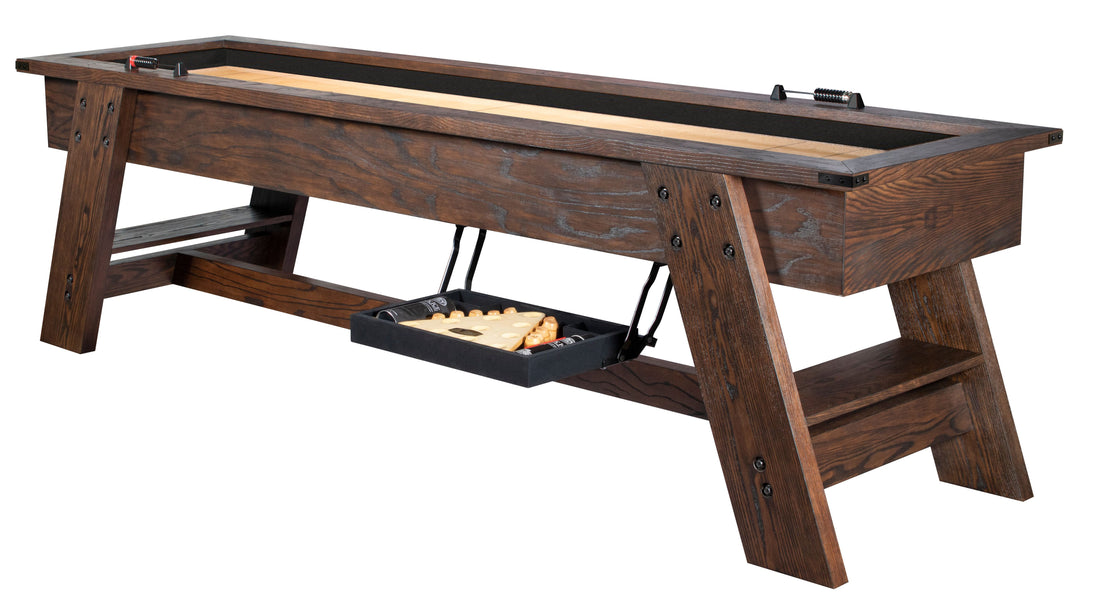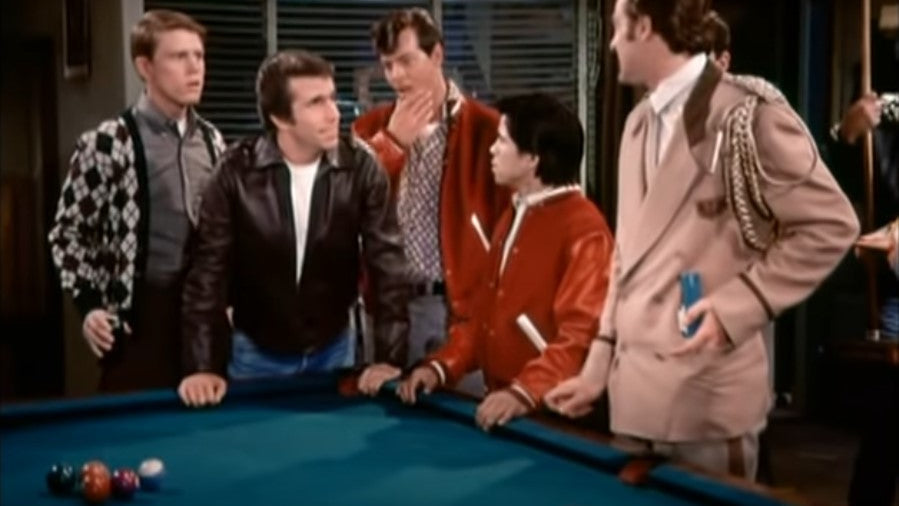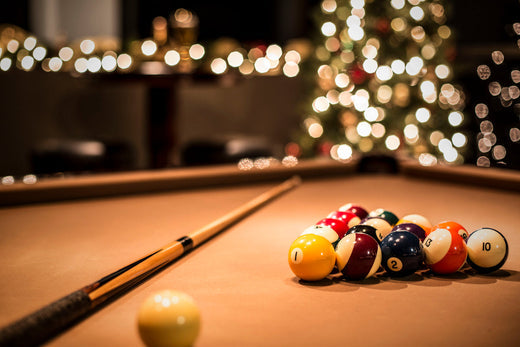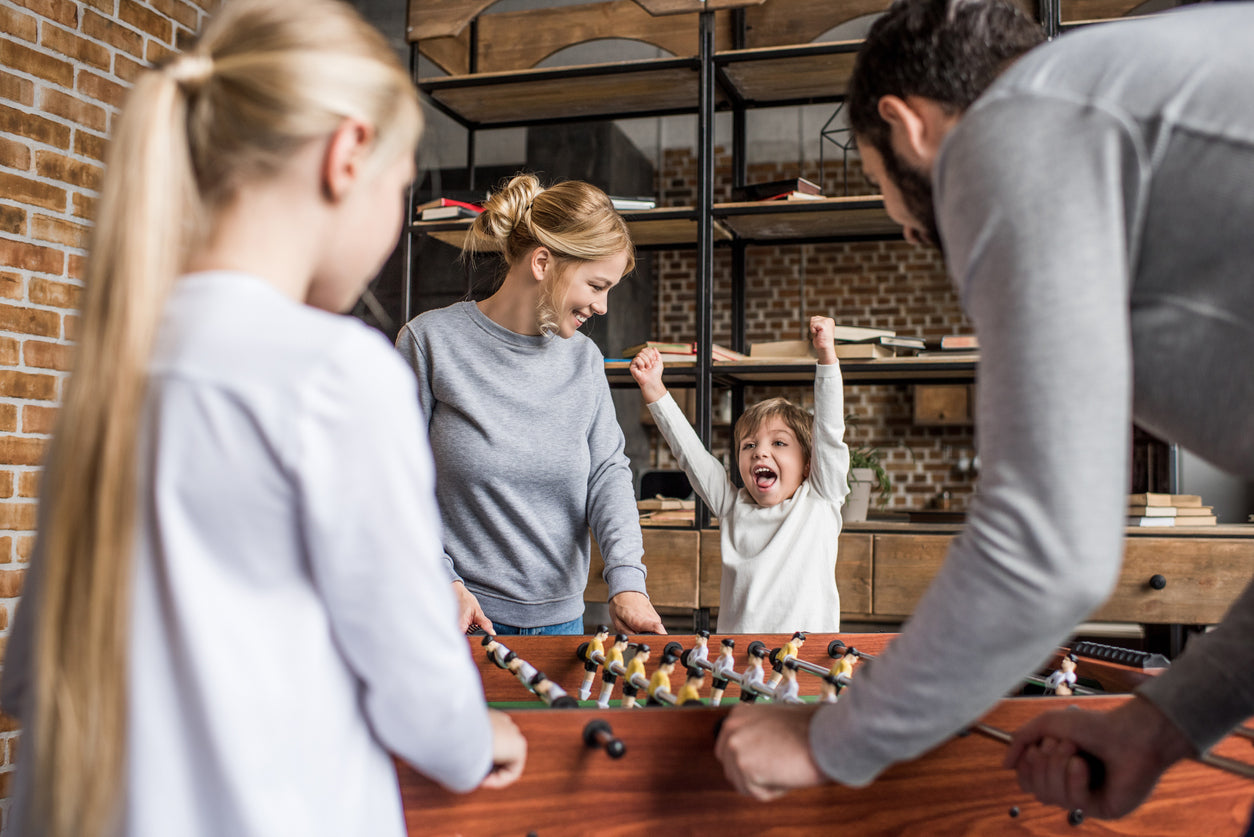Table Shuffleboard is a game where players take turns sliding weighted pucks down a long, smooth table made of wood. The end of the table is marked with specific areas for scoring.
History
Shuffleboard is believed to have its origins in England, around the 1400s. At that time, players would play a game called “Shoffe-Groat”, sliding a large 4-pence coin (a “groat”) down a long table with points being scored for getting the coin as close to the edge of the table as possible, without falling off.
King Henry the VIII was known to be a shuffleboard player, as he is on record as having lost nine pounds to Lord William playing the game. He is also known for having outlawed the game with commoners, as he felt it distracted them from their daily duties.
Shuffleboard is also reported to have been popular with early American colonists. The play “The Crucible”, which chronicles the Salem Witch Trials of the late 1600s, mentions 1692 as a year where there were plenty of “ne’er do wells” (lazy, worthless individuals) gathered around the shuffleboard in the local tavern.
Also of historical significance is an 1848 legal case, The State vs. John Bishop. Bishop was a tavern owner accused of running a game of chance in the form of a shuffleboard without a license to do so. The judge, however, ruled that shuffleboard was indeed not a game of chance, but a game of skill.
Towards the end of the nineteenth century, shuffleboard was taking off as a competitive sport, particularly around New York City. Newspapers reported the results with the same regularity as baseball, boxing and other sports.
As shuffleboard was primarily played in taverns, prohibition had a very detrimental impact on the game. In the 1920s many taverns closed, leaving their shuffleboard tables idle. The Great Depression of the 30s was a source of trouble for many people however, so when prohibition was lifted, shuffleboard once again became popular as an outlet for stress.
During the war, the 1940s were also troubled times, and once again shuffleboard provided a sense of release. For some it was a source of intense competition, for others it was merely an enjoyable way to pass the time. Its base of players grew, however, and even Hollywood celebrities were having tables installed in their homes.
The 1950s saw shuffleboard reach its peak in popularity. Tournaments were nationwide, often sponsored by shuffleboard manufacturers. Although the sport declined over the next couple of decades, in the mid-80s it began to see a revival.
The 1990s saw the formation of the TSA, or Table Shuffleboard Association, which established a hall of fame to immortalize the very best players of the sport.
The Table
The official shuffleboard table length is twenty-two feet long by twenty inches wide, although unofficially sizes can be as short as nine feet, still preserving the width.
 At each end of the table, roughly one third is covered by three scoring areas. Each scoring area covers the width of table although they can vary in length. The area closest to the edge of the table, marked with a “3” meaning three points, and is roughly four to five inches in length. Equal in length is the adjacent scoring area, marked with a “2” for two points. Next to this is the “1” section, for one point. This section is roughly four times as long either of the other two sections. The lines that separate the centre of the table from scoring areas is called the “foul line”. A shot must pass the foul line closest to the player, or else it is removed from play. Around the table is a gutter, called the “alley”. Pucks that fall or are knocked into the alley are considered out of play for that round.
At each end of the table, roughly one third is covered by three scoring areas. Each scoring area covers the width of table although they can vary in length. The area closest to the edge of the table, marked with a “3” meaning three points, and is roughly four to five inches in length. Equal in length is the adjacent scoring area, marked with a “2” for two points. Next to this is the “1” section, for one point. This section is roughly four times as long either of the other two sections. The lines that separate the centre of the table from scoring areas is called the “foul line”. A shot must pass the foul line closest to the player, or else it is removed from play. Around the table is a gutter, called the “alley”. Pucks that fall or are knocked into the alley are considered out of play for that round.
Shuffleboard Powder
To keep play smooth, large amounts of a product made called “shuffleboard powder” are sprinkled generously on the table.
Shuffleboard powder enables the puck to slide smoothly across the board. The silicone beads act like tiny ball bearings, enabling a puck to slide down the table with a minimal amount of effort.
Although it is also known as shuffleboard wax, it is indeed a powder made from dried silicone beads and cornmeal (long ago it was made from sawdust), as opposed to a liquid. It is sold in a container that looks similar to powdered bleach cleanser, complete with holes that allow for even distribution across the table. It is recommended to store the powder in a dark, dry place.
Shuffleboard powder is available in a variety of types, for varying table sizes and speed preferences. Some players prefer a game with faster action, whereas others prefer more control over the puck.
Shuffleboard Rules
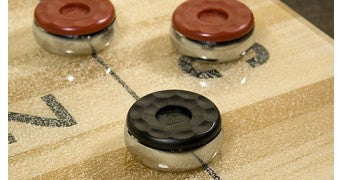 In the interest of good sportsmanship, it is recommended that all players shake hands before the game begins. Deciding who goes first can be done a number of ways, however the simplest way is to flip a coin. Remember that it is advantageous to go second. After the first round is played, the winner plays first on the next round.
In the interest of good sportsmanship, it is recommended that all players shake hands before the game begins. Deciding who goes first can be done a number of ways, however the simplest way is to flip a coin. Remember that it is advantageous to go second. After the first round is played, the winner plays first on the next round.
Players use red or blue-colored pucks to indicate which player (or team) they belong to. Players take turns sliding their puck down the table. The main goal is to get the pucks as close to the end of the board as possible without falling off the end.
The center is separated from each end of the table by two lines called “foul” lines. When the player takes a shot, the shot must pass the foul line closes to the player, otherwise it is removed from the table, as it is deemed being in the “illegal zone”. Surrounding the table is a gutter called the “alley”. Pucks that fall into the alley are out of play for the remainder of the round.
When shooting, you can hit the pucks of your opponent. The idea is to try and hit your opponent’s pucks out of play by pushing them into the alley, while moving your pucks into a higher-scoring location. If your puck passes the foul line, then bounces off a puck and returns to the illegal zone, both your puck and your opponent’s are removed from play.
After each player has shot four pucks, the round is finished. When scoring at the end of the round, points are awarded only to the player whose puck is closest to the edge of the table. Your puck can only score points if it is on the table, over the foul line, and closer to the end of the table than any of your opponent’s pucks.
A puck that overhangs the edge of the table receives four points. A puck that is in one of the scoring zones receives points according to its zone (one, two, or three points). A puck that is touching the line between zones receives points only from the lowest zone. For example a puck in zone two that is touching the line for zone one would only receive one point).
If there are two players, the first one to reach fifteen points is the winner. If there are four players in a ‘doubles’ match, the first team to reach twenty-one points wins.
Certain violations that will result in a one-point penalty. To avoid this, make sure that you do not rub your hands over the playing surface, and avoid extending the lower half of your body past the end of the board. While your opponent is shooting, do not hold a playing puck in your hand. Avoid touching the actual playing surface with either hand before, during or after making a shot (although it is permissible to touch the frame).
In a doubles match, teammates stand on the opposite end of the table and play every other round, shooting from alternating ends of the table. Essentially it is like playing two games of shuffleboard at the same time, and combining the scores of each team. During a doubles match, player are not allowed to to go the other end of the board to see the position of the pucks. If you want to know about a puck’s position, you must ask your partner and rely on their information. Going beyond the foul line at any time during the round results in a penalty.
Touching a puck that is in play is not permissible while anyone else is shooting, whether it’s your opponent or your partner. The same is true for touching the playing surface or the table frame. Also, any pucks in the gutter should not be touched until the round is finished. Causing any table vibrations will result in a penalty, even if the vibration is accidental, such as hitting the floor. As a rule of etiquette, it’s best to stand far back and give your opponents lots of room when they are shooting.
Variations
While shuffleboard organizations have agreed upon some official rules, the informal and spontaneous nature of shuffleboard lends itself to a wide variety of house rules, regional variations, and variations by country.
In Canada, for example, shuffleboard is played according to rules that have been approved by the Canadian Shuffleboard Congress. In most tournaments, singles games are played to a score of fifteen. Doubles matches are played to twenty-one points. In both situations, a round consists of four pucks per player.
Bumper Shuffleboard
Sometimes known as backboard or cushion shuffleboard, bumper shuffleboard replaces the traditional gutters at the sides of the table with cushions, enabling players to bounce their pucks off the sides of the table, which can be useful for maneuvering around an obstructing puck. Typically bumper shuffleboards are twelve to thirteen feet in length - shorter than a typical shuffleboard.
Sjoelen
Sjoelen, or Dutch Shuffleboard, is played mainly in The Netherlands, Belgium and Germany. It uses a wooden board roughly 6.6 feet long by 1.3 feet wide. Instead of pucks, it uses wooden disks. About seventeen inches from the front of the board, a flat bar of wood is positioned above the table, and the disks pass under it. This is called the “start bar”. About fifteen inches from the back of the board is the “gate bar”, which is a piece of wood with four slot holes in it. These slots are marked, from left to right, as two, three, four and one. Behind this gate, the board is divided into four equal partitions.
When playing the game, each player takes one turn, with the winning player being the one with the highest score. Each turn is comprised of three chances to slide all the disks down the board, aiming for the numbered compartments. Each chance is called a “sub-turn”. Players will aim to get a disk into each of the four compartments, as doing so doubles the scoring value of all the disks.
In first sub-turn, the player slides all thirty disks. At the end of the turn, any disks that have made their way into compartments stay there, but are stacked in piles at the end of the container, to keep the compartment entrances clear. If all thirty disks have entered compartments, the turn ends. Otherwise, the player gets another chance to shoot the remaining disks. At the end of the second sub-turn, once again disks that have entered compartments are stacked neatly, and remaining disks can be shot again by the player. This third sub-turn is the player’s last chance to get the disks inside the compartments, after which the turn ends and the score is calculated.
To be counted as being inside the compartment, the whole disk must pass across the front face of the gate bar. If a dispute arises, a “gate stopper” can be pushed flat against the front gate bar. If the disk moves when the gate stopper is pushed, then it was not fully in the compartment.
Any disks that have completely passed under the start bar should be considered in play and must not be touched until the end of that sub-turn. The only exceptions would be if a disk enters a compartment via some other method than through the slot of that compartment, falls off the board, exits a compartment other than through it’s slot, or returns under the start bar. In any of these cases, the disk is removed from play, but may be used in the next sub-turn.
Sjoelen Scoring
In Sjoelen, scoring is determined first by counting the disks in each of the compartments. Getting a disk in each compartment causes a double score for those disks, creating a total of twenty points ((1+2+3+4)x2=20). After each set of four disks is counted, the remaining disks are awarded a score of the number shown in their compartment.
To give an example a player has five disks in slot two, nine disks in slot three, five disks in slot four, and seven disks in slot one. The player then has five complete sets of disks, scoring one hundred points. There are four remaining disks in slot three, scoring twelve points (4x3=12). There are also two remaining disks in slot one, scoring two points (1x2=2). Therefore, the player’s total score is one hundred and fourteen points (100+12+2=114).
The maximum possible score should be one hundred and forty-eight (seven sets of twenty plus two discs in the four points slot). However, a player managing to do this within two sub-turns with receive an extra disk, making the total possible score one hundred and fifty-two points.
In competitions, matches typically consist of a set number of games such as five, ten or twenty, and the total score from all games will be used to determine the match winner. As boards can vary widely, players are usually permitted to throw five practice disks before the game begins.
Shove Ha’penny
Shove Ha’penny is popular in England. Like Shuffleboard, it is a descendent of Shoffe-Groat, where alternating players push coins up a board featuring horizontal lines. The space between each pair of lines is called a “bed”, and the goal is to push the coins os they land directly in the beds without touching the lines. The winner must get a coin in each bed three times. A player who can score three coins in one bed during a single turn scores a “sergeant” and a player scoring all five coins in a single turn earns a “sergeant major” or “gold watch”.
Pushing is usually done with the heel of the hand, although other techniques are used including the palm, side of the thumb or fingers. To keep the board slippery, a variety of substances can be used including beer, paraffin, black lead, and beer, although traditionally French chalk is used, with talcum powder being a modern choice. Each coin has been smoothed down on one side. Although legally speaking, the tails side of the coin should be smoothed so as to avoid defacing an image of the monarch, there are many who smooth the heads side anyway. This has the added advantage of leaving the date of the coin visible, as ideally the coins should all be from the same year.
Shove Ha’penny is believed to have started around 1840. Originally, the game would have been played on any flat surface, and the lines would just be drawn not he surface. In modern times, however, official boards are made from slate or hardwood and the lines are indented on the surface. Premium boards have rails inside the dents. The purpose of these rails is to settle disputes about whether or not a coin is touching a line. Upon raising the rails, if the coin moves, it is touching the line and therefore does not receive any points.
Rules
Boards can vary in size, but a typical board roughly twenty inches by fourteen inches. Each horizontal line is roughly one thirty-second of an inch. The first horizontal line is four inches from the front of the board and the last horizontal line is roughly five inches from the board’s end. The nine beds between the lines are one and a quarter inches wide. A piece of wood may be added to the end of the board to keep ha’pennies from sliding off.
A line runs vertically, roughly one and a quarter inches from either side, so that the end of the board is comprised of a square scoring area. An inch and a quarter in from either side, a vertical line runs the length of the board. As each bed lies horizontally, this creates a square spot at the end of each bed, which is used to mark the score.
Players take turns shoving five coins up the board. The ha’penny is positioned at the front of the board, with the end of the coin just coming over the front edge of the board. From this position, any part of the player’s hand can then be used to shove the coin. If the coin does not make it to at least the first line on the board, it can be shoved again.
After each turn is complete, each coin that is completely within a bed and not touching any lines scores a point for that player in that bed. Chalk is used to mark the score on the end of the square of each bed, with each side of the board belonging to a different player. For example, if the right side of the board marks one player, the other player is marked on the left side. The goal is to get three chalk marks in each square, with three coins in each of the nine beds. Once three scores have been made in a bed, however, any additional scores will be awarded to the opponent, unless the opponent already has three scores in that bed. The exception to this rule is that the winning point must be scored by the winning player, not given away as a penalty.
Experienced players will try to cause a coin to knock onto previously pushed ha’pennies to get them in a better position, at the same time scoring with the ha’penny they are playing. Strategy and skill is required to truly become proficient at the game.
Outdoor Shuffleboard
Outdoor shuffleboard should not be confused with Deck Shuffleboard, which will be discussed later. An outdoor shuffleboard court is long and rectangular, having both ends marked with scoring areas. The full court is fifty-two feet long, and the six and a half feet from the end is a line called the "baseline". The area from the baseline to the end of the court is called the shooting area. One and a half feet past the baseline is the "10 Off" area, with 10 Off meaning minus ten points. The 10 Off area is divided in the middle by a thin triangle, as well as on either edge by two angled lines.
The next line is the start of a triangle known as the scoring area, which is nine feet to the tip. The triangle consists of five areas. The small area closest to the tip is marked 10 for ten points, and adjacent to this are two equal-sized areas marked 8 for eight points. Finally, between these areas and the afore-mentioned 10 Off area are two equal-sized areas marked 7 for seven points. The middle of the court is divided by two lines called the “dead lines”. Disks that are shot must pass the dead line furthest from the shooter to be in play.
Disks have a diameter of six inches, and are between nine-sixteens of a inch and one inch thick. A typical disk weight is fifteen ounces. Traditionally the disks are black and yellow, with four of each color used to play the game. The cues are poles, no more than six and a half feet long with two short prongs on the end, and they are used to slide the disks.
The player with the yellow disks starts, and players take turns sliding disks down the court. Initially, the four disks are placed in the left half of the 10 Off area and the black disks in the right half. The small thin triangle acts as a divider between each side. A cue must be used to slide each disk, and the slide needs to start within the 10-off area and finish within the scoring triangle closest to the player. If the disk doesn’t slide far enough to pass the dead line furthest from the player, it is immediately removed from play as is any disk that slides off the edge of the court.
Players will try to slide their own disk into the scoring areas while attempting to knock the disks of their opponents into out-of-play positions or the 10 Off area.
There are a variety of situations where penalties are awarded. If a disk touches the 10 Off area line before being played, the player loses five points. If a disk touches the side line or the side of the dividing triangle when being played, the player loses ten points. If any part of the player’s body touches or goes beyond the base line when playing a disk, there is a ten point penalty. Also, shooting a disk belonging to an opponent costs a player ten points. Finally, illegal shots are immediately removed from play, as well as any disks that were moved from their position by an illegal disk. Any disks belonging to the opponent of the offender are returned to said opponent to be played again. If the offender displaced any disks in the 10 Off area, causing them to be removed, the offender is awarded a penalty of ten points per disk.
After all eight disks have been played, the score can be counted. For a disk to count for points, it must be completely within a scoring area and not touching any lines that border the area. Disks in the 10 Off area are counted as minus ten points. Disks beyond the 10 Off area are not counted in the scoring. Disks on top of other disks still store. To judge if a disk is touching a line, a person should stand so their eyes are directly above any disks.
Rounds continue in this fashion, the first player to reach seventy five points is declared the winner, although play will not stop in the middle of a round. Each round must be played in full and scores properly calculated before victory can be declared.
Deck Shuffleboard
Deck Shuffleboard is played on a court with two oval-shaped scoring areas, separated by a thirty-foot distance. Each oval contains nine square-shaped scoring areas, each marked with a different number to reflect the number of points it awards. A thin, wide area caps the top of the oval marked +10 meaning plus ten points, and an equal-sized area at the bottom is marked -10 meaning minus ten points. The entire oval is six feet from front to back, and a foot from the oval, towards the edge of the court, is the gentlemen’s line. The ladies’ line is two feet from the oval’s other side.
The game is played by using cues, which are long sticks with “shoes” on the end. These shoes are wooden rectangles with a half-circle cut into them, so they can accommodate a disk. The players shoot wooden disks. Each disk has a diameter of roughly six inches. There are eight disks in all, four disks for each player or team. Different colors are used to distinguish between players or teams.
A coin toss decides which player goes first. Players take turns sliding disks from behind the Gentleman’s line. One key goal when playing is to try and hit disks that are currently in play. A player will try to knock her discs into a more favorable position, and try to knock her opponents’ discs into the -10 spot or into a position where they are no longer in play. A disk that does not reach the ladies’ line is immediately removed from play.
Once all disks have been shot, disks that are completely within a scoring area, not touching any lines, score the value indicated in the area. Players may then start a new turn from the opposite end of the court, shooting at the alternate scoring area.
Rounds continue until one player reaches a pre-determined score, usually fifty or one hundred points. If doubles are played, all players shoot from the same end of the court.
Thank you for reading our article about shuffleboards. If you are interested in purchasing a shuffleboard table, see our catalog.


